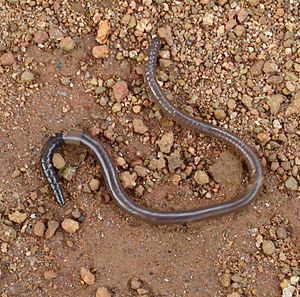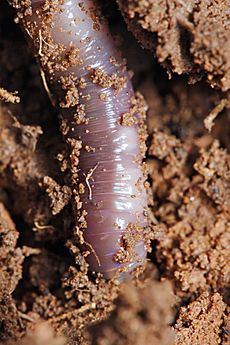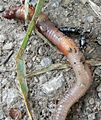Earthworm facts for kids
Quick facts for kids Earthworm |
|
|---|---|
 |
|
| An unidentified earthworm species with a well-developed clitellum | |
| Scientific classification |
|
| Kingdom: | Animalia |
| Phylum: | Annelida |
| Class: | Clitellata |
| Order: | Opisthopora |
| Suborder: | Lumbricina |
An earthworm is a small animal without a backbone. It lives in the ground. Earthworms are found all over the world where the soil, water, and temperature are right.
Earthworms are super helpful! They dig tunnels and mix the soil. This makes the soil healthier and full of good stuff for plants. Farmers and gardeners love having lots of earthworms. Even Charles Darwin, a famous scientist, said in 1881 that earthworms have played a very important part in the world's history.
Contents
- What an Earthworm Looks Like
- How Big Do Earthworms Get?
- Where Earthworms Live
- What Earthworms Eat
- Earthworm Reproduction
- Earthworm Life Cycle
- How Earthworms Move
- Earthworm Types and Roles
- Who Eats Earthworms?
- How Earthworms Help the Environment
- Earthworms and Money
- Cool Facts About Earthworms
- Images for kids
- See also
What an Earthworm Looks Like
Most earthworms are reddish-brown. Both ends of their body look a bit pointed. They don't have eyes or a clear face, just a simple opening for a mouth.
Earthworms have long bodies made of many segments, like rings. They have tiny bristles called setae (say: SEE-tee) on their bodies. These bristles help them grip the ground and pull themselves along. They use special muscles to move.
Earthworms don't have lungs. They breathe by taking in oxygen right through their skin. To do this, their skin must stay wet. They keep their skin moist with a special slime their body makes.
Earthworms are invertebrates, meaning they don't have a skeleton. Their body is supported by fluid inside them. Sometimes, you might see a "belt" or "saddle" around an earthworm's body. This part is called a clitellum. It holds the eggs as they get ready to hatch.
How Big Do Earthworms Get?
Earthworms come in many sizes. They can be as small as two centimeters (less than an inch). But some can grow up to about three meters (almost 10 feet) long!
The biggest known earthworm is the giant Gippsland earthworm. It lives in Australia. It's usually about 80 centimeters (31 inches) long. But it can grow to be about 2 meters (6.5 feet) long!
The most common earthworm in places like Europe usually grows to about 20-25 centimeters (8-10 inches) when stretched out.
Where Earthworms Live
Earthworms are usually found in soil. You can find them almost everywhere. They don't live in very cold or very dry places.
Earthworms like soil that is damp but not too wet. They also like loose soil. You can find them in piles of fallen leaves. After it rains, they often come to the surface. This happens because their tunnels fill with water. Many gardeners like earthworms. They make the soil better and richer with their droppings. Earthworms are also happy in compost piles. They love to eat rotting plants there. You can spot an earthworm's home by the small piles of dark, sand-like droppings around the entrance. These droppings are called casts.
What Earthworms Eat
Earthworms mostly eat decaying plants, fallen leaves, tiny fungi, and other small living things. They are very important for the environment. They break down dead organic matter. Then they pass it through their body. This turns it into new, rich soil.
An earthworm doesn't have teeth. So, it swallows tiny bits of grit. This grit helps grind up food in its stomach. As an earthworm digs and eats, it makes tunnels in the soil. This helps air get into the soil. It also brings nutrients from deeper soil layers up to the top. This helps new plants grow. That's why farmers and gardeners around the world value them so much.
Earthworm Reproduction
Earthworms are hermaphrodites. This means each worm has both male and female parts. When two earthworms mate, they both exchange sperm. Then, their eggs get fertilized.
The "belt" or "saddle" you see on an earthworm is called the clitellum. It makes a slimy substance. This substance forms capsules that protect the eggs. Inside these capsules, sperm and eggs join to form embryos. Each capsule can hold 1 to 20 eggs.
The eggs take about 60 to 90 days to hatch. This time depends on things like how wet it is and the temperature. An earthworm takes up to a year to grow into an adult. In the wild, they can live for 4 to 8 years.
Earthworm Life Cycle
When earthworms are born, they are small but fully formed. They just don't have their adult reproductive parts yet. These parts grow in about 60 to 90 days. They become fully grown in about one year. Scientists think that earthworms in nature live for four to eight years. But many garden earthworms only live for one to two years.
How Earthworms Move
Earthworms move underground by using their muscles. They make their body shorter and then longer. As they dig, their body makes a slippery slime. This slime helps them slide through their tunnels. When they move through these wet tunnels, they can sometimes make gurgling noises.
Earthworms push through the soil by making cracks wider. Baby earthworms are very strong for their size. They can push 500 times their own body weight! Big adult worms can push about 10 times their own body weight.
Earthworm Types and Roles
Earthworms are grouped into three main types based on how they live:
- Surface Dwellers: These worms live in leaf litter or compost. They don't dig deep burrows. They eat decaying plants on the surface.
- Topsoil Dwellers: These worms live in the top layers of soil. They eat soil and dig horizontal tunnels. These tunnels are usually in the top 10–30 centimeters (4-12 inches) of soil.
- Deep Burrowers: These worms build permanent, deep vertical tunnels. They use these tunnels to pull plant material, like leaves, down from the surface to eat.
Who Eats Earthworms?
Many animals love to eat earthworms!
- Birds: Robins, starlings, thrushes, gulls, and crows.
- Reptiles: Snakes and wood turtles.
- Mammals: Bears, boars, foxes, hedgehogs, pigs, and moles.
- Invertebrates: Ants, flatworms, ground beetles, snails, spiders, and slugs.
Earthworms can also have tiny parasites living inside them. These parasites can be in their blood, guts, or even their cocoons.
How Earthworms Help the Environment
Earthworms are super important for making soil healthy for farming. Here's how they help:
- Biological Help: Earthworms turn big pieces of dead plants into rich, dark soil called humus. This makes the soil much more fertile.
- Chemical Help: Earthworms eat dead plants and tiny soil bits. They grind everything up in their gut. When they poop out their casts, they release minerals and nutrients. These nutrients are then easy for plants to use.
- Physical Help: By digging tunnels, earthworms keep the soil structure good. Their tunnels help air get into the soil. They also help water drain well.
Earthworms and Money
Different kinds of worms are used in something called vermiculture. This is when people feed organic waste, like food scraps, to earthworms. The worms then break down the waste. The most common worms for this are Eisenia fetida (also called tiger worms or red wigglers). These are different from the worms that live in garden soil.
Earthworms are sold all over the world. For example, in 1980, Canada exported 370 million worms! These worms were worth $13 million from Canada. They were sold for $54 million in America.
Earthworms are also a great source of protein for fish, chickens, and pigs. Some cultures have even eaten them! The Māori of New Zealand call earthworms Noke. They consider them a special food for their chiefs.
Cool Facts About Earthworms
- An earthworm breathes through its skin.
- Earthworms are hermaphrodites: each one has both male and female parts.
- They don't have a true skeleton. Instead, fluid inside their body acts like a water-filled skeleton to keep their shape.
- There are about 5,500 known types of worms.
- An earthworm's digestive system is as long as its whole body.
- Most earthworms can regrow parts of their body if they get cut. But this depends on how much damage there is and what type of worm it is.
- The longest worm ever recorded was Amynthas mekongianus. It was found near the Mekong River and could stretch up to 3 meters (10 feet) long!
- Salt on human skin is bad for earthworms. It dries them out. That's why they wiggle when you touch them with bare hands.
- An earthworm has a brain, nerves, and a heart.
- Out of about 7,000 species, only about 150 types of earthworms are found all over the world. These are called cosmopolitan earthworms.
- In the United States and Canada, about one-third of the earthworm types found were brought there from other places.
- Nitrogen fertilizers can make the soil too acidic. This is deadly for earthworms.
- The number of earthworms in the soil can tell you how healthy the soil is. More worms usually mean healthier soil.
- Studies in the U.S. show that fresh earthworm droppings (casts) are much richer in important plant nutrients. They have five times more nitrogen, seven times more phosphates, and 11 times more potassium than the top 6 inches of soil around them.
- It's estimated that each person alive today is supported by about 7 million earthworms!
Images for kids
-
A Devil's coach horse beetle eating an earthworm.
-
Earthworm droppings called casts.
See also










